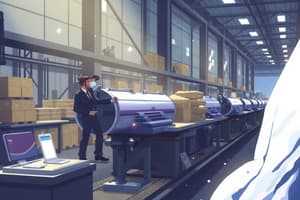Podcast
Questions and Answers
What is a key benefit of integrating ERP systems with activity-based costing systems?
What is a key benefit of integrating ERP systems with activity-based costing systems?
- It eliminates the requirement for process controls.
- It simplifies the budgeting process without any formal measures.
- It improves the accuracy and availability of activity cost driver information. (correct)
- It reduces the need for direct costs calculation.
How do ERP systems contribute to production planning and materials management?
How do ERP systems contribute to production planning and materials management?
- By eliminating the need for JIT systems.
- By linking production planning directly to organizational sales forecasts.
- By facilitating communication along the supply chain. (correct)
- By focusing solely on financial metrics.
What role does activity-based budgeting play in the context of ERP systems?
What role does activity-based budgeting play in the context of ERP systems?
- It does not require the collection of nonfinancial measures.
- It anticipates demand and estimates practical capacity. (correct)
- It focuses exclusively on financial indicators.
- It relies only on historical data for planning.
Which of the following is NOT a feature of SAP’s R/3 system related to materials management?
Which of the following is NOT a feature of SAP’s R/3 system related to materials management?
What is a challenge that activity-based costing systems face according to the content?
What is a challenge that activity-based costing systems face according to the content?
Which characteristic of ERP systems contributes to improved process integrity?
Which characteristic of ERP systems contributes to improved process integrity?
What does activity-based costing allow businesses to do regarding direct costs?
What does activity-based costing allow businesses to do regarding direct costs?
What aspect of traditional production systems is regarded as a limitation?
What aspect of traditional production systems is regarded as a limitation?
What is the primary goal of a manufacturing execution system (MES)?
What is the primary goal of a manufacturing execution system (MES)?
What is a disadvantage of traditional production systems addressed by ERP systems?
What is a disadvantage of traditional production systems addressed by ERP systems?
Which of the following processes is NOT part of Material Resource Planning (MRP)?
Which of the following processes is NOT part of Material Resource Planning (MRP)?
Which component does the Materials Management System NOT directly support?
Which component does the Materials Management System NOT directly support?
What is a major benefit of Just-in-Time (JIT) systems?
What is a major benefit of Just-in-Time (JIT) systems?
What does capacity planning primarily evaluate?
What does capacity planning primarily evaluate?
Which factor is essential for accurate production planning?
Which factor is essential for accurate production planning?
What does the acronym APS stand for in the context of materials management?
What does the acronym APS stand for in the context of materials management?
How does ERP enhance materials management efficiency?
How does ERP enhance materials management efficiency?
Which of these is NOT a function of the production planning system?
Which of these is NOT a function of the production planning system?
What role does collaborative demand management play in ERP systems?
What role does collaborative demand management play in ERP systems?
Which is a challenge faced by Atlantic Manufacturing as mentioned?
Which is a challenge faced by Atlantic Manufacturing as mentioned?
In the context of ERP, what does demand management fundamentally address?
In the context of ERP, what does demand management fundamentally address?
What aspect is prioritized in accurate production scheduling?
What aspect is prioritized in accurate production scheduling?
Activity-based costing systems always rely on financial measures for accuracy.
Activity-based costing systems always rely on financial measures for accuracy.
ERP systems improve the reliability of cost driver information by integrating multiple systems.
ERP systems improve the reliability of cost driver information by integrating multiple systems.
The number of pallet moves is considered an indirect cost driver in materials handling.
The number of pallet moves is considered an indirect cost driver in materials handling.
Activity-based budgeting is solely focused on historical data from previous processes.
Activity-based budgeting is solely focused on historical data from previous processes.
Traditional production systems typically provide a high level of integration within an organization.
Traditional production systems typically provide a high level of integration within an organization.
ERP systems do not enhance communications along the supply chain.
ERP systems do not enhance communications along the supply chain.
Nonfinancial measures used as drivers in ERP systems are collected through a formal process.
Nonfinancial measures used as drivers in ERP systems are collected through a formal process.
Direct costs in activity-based costing can be calculated as part of overhead costs.
Direct costs in activity-based costing can be calculated as part of overhead costs.
SAP’s R/3 system integrates production planning solely without links to material management.
SAP’s R/3 system integrates production planning solely without links to material management.
The primary goal of activity-based budgeting is to reduce labor costs at any expense.
The primary goal of activity-based budgeting is to reduce labor costs at any expense.
The primary objective of Just-in-Time systems is to maintain excess inventory levels.
The primary objective of Just-in-Time systems is to maintain excess inventory levels.
The main advantage of integrating ERP systems is to increase lead times during production.
The main advantage of integrating ERP systems is to increase lead times during production.
Material Resource Planning (MRP) utilizes estimated production goals to dictate when materials should be ordered.
Material Resource Planning (MRP) utilizes estimated production goals to dictate when materials should be ordered.
In the 1960s through the 1980s, production systems were primarily focused on low-volume production of many products.
In the 1960s through the 1980s, production systems were primarily focused on low-volume production of many products.
One of the problems with traditional production systems is the lack of integration between sales and production divisions.
One of the problems with traditional production systems is the lack of integration between sales and production divisions.
Quality control in production systems only involves monitoring finished products and does not include incoming materials.
Quality control in production systems only involves monitoring finished products and does not include incoming materials.
ERP systems enhance productivity by eliminating paperwork and bottlenecks in production processes.
ERP systems enhance productivity by eliminating paperwork and bottlenecks in production processes.
Capacity planning simply estimates the amount of raw materials needed for production without considering production goals.
Capacity planning simply estimates the amount of raw materials needed for production without considering production goals.
The main role of Material Management Systems is to solely track finished products.
The main role of Material Management Systems is to solely track finished products.
Data collection systems within ERP support operational-level processes by providing real-time information.
Data collection systems within ERP support operational-level processes by providing real-time information.
Flashcards
ERP Production Management
ERP Production Management
ERP component managing the production process, connecting it to sales and inventory.
Materials Management in ERP
Materials Management in ERP
ERP component overseeing the acquisition and use of materials; links to purchasing, receiving, and quality control.
Traditional Production Systems Problem
Traditional Production Systems Problem
Lack of integration between departments (sales, production, etc.) leads to incorrect forecasts, inventory issues, and financial problems.
Production Planning Objectives
Production Planning Objectives
Signup and view all the flashcards
Material Requirements Planning (MRP)
Material Requirements Planning (MRP)
Signup and view all the flashcards
Just-in-Time (JIT) Systems
Just-in-Time (JIT) Systems
Signup and view all the flashcards
Capacity Planning
Capacity Planning
Signup and view all the flashcards
ERP Integration Impact
ERP Integration Impact
Signup and view all the flashcards
Manufacturing Execution Systems (MES)
Manufacturing Execution Systems (MES)
Signup and view all the flashcards
eBusiness Strategies in Production
eBusiness Strategies in Production
Signup and view all the flashcards
ERP systems and Activity-Based Costing
ERP systems and Activity-Based Costing
Signup and view all the flashcards
Activity-Based Costing Systems
Activity-Based Costing Systems
Signup and view all the flashcards
Activity Cost Driver
Activity Cost Driver
Signup and view all the flashcards
SAP R/3 system
SAP R/3 system
Signup and view all the flashcards
Activity-Based Budgeting
Activity-Based Budgeting
Signup and view all the flashcards
Traditional Production Systems
Traditional Production Systems
Signup and view all the flashcards
ERP System Purpose
ERP System Purpose
Signup and view all the flashcards
Data Integration (in Management Decision Making)
Data Integration (in Management Decision Making)
Signup and view all the flashcards
ERP Production Management
ERP Production Management
Signup and view all the flashcards
Materials Management
Materials Management
Signup and view all the flashcards
Traditional Production Problems
Traditional Production Problems
Signup and view all the flashcards
Production Planning Goals
Production Planning Goals
Signup and view all the flashcards
Material Requirements Planning (MRP)
Material Requirements Planning (MRP)
Signup and view all the flashcards
Just-in-Time (JIT) Systems
Just-in-Time (JIT) Systems
Signup and view all the flashcards
Capacity Planning
Capacity Planning
Signup and view all the flashcards
ERP Integration Benefits
ERP Integration Benefits
Signup and view all the flashcards
Manufacturing Execution Systems (MES)
Manufacturing Execution Systems (MES)
Signup and view all the flashcards
E-business in Production
E-business in Production
Signup and view all the flashcards
ERP & Activity-Based Costing
ERP & Activity-Based Costing
Signup and view all the flashcards
Activity-Based Costing Systems
Activity-Based Costing Systems
Signup and view all the flashcards
Activity Cost Driver
Activity Cost Driver
Signup and view all the flashcards
SAP R/3 System
SAP R/3 System
Signup and view all the flashcards
Activity-Based Budgeting
Activity-Based Budgeting
Signup and view all the flashcards
Traditional Production Systems Problem
Traditional Production Systems Problem
Signup and view all the flashcards
ERP System Benefits
ERP System Benefits
Signup and view all the flashcards
Data Integration Impact
Data Integration Impact
Signup and view all the flashcards
Study Notes
Enterprise Resource Planning (ERP) Systems: Production and Materials Management
- ERP systems integrate production and materials management processes.
- The objectives of this chapter are to examine production and materials management within ERP systems, and to understand how they work together.
- Atlantic Manufacturing faced issues like inconsistent raw materials and finished products, late change specifications, long lead times, and inadequate information sharing between divisions. This highlighted the weaknesses of traditional production systems.
- Manufacturing systems evolved from re-order inventory models in the past to high-volume production then dynamic, flexible production models. Mainframe-based databases helped production of new products to meet customer needs, as well as enabling flexible production capabilities.
Problems with Traditional Production Systems
- Lack of integration between divisions in an organization's production processes.
- Production disconnected from sales, resulting in incorrect inventory levels and inaccurate purchasing decisions.
- Inconsistent production forecasts lead to shortages or excess raw materials, and excess finished products or shortages.
- Excess inventories negatively impacted cash flow and profitability.
Production Systems Objectives
- Create production plans.
- Acquire raw materials.
- Schedule equipment, facilities, and human resources appropriately.
- Design products.
- Produce goods with appropriate quantities and quality levels.
Production Planning and Manufacturing Processes (Operational Level)
- Daily activities encompass purchasing the correct quantity of raw materials and supplies, receiving and inspecting deliveries, quality control (monitoring quality and unacceptable deliveries), and inventory management.
Information Systems Support
- Production planning and manufacturing processes are supported by data collection systems, material management systems, bill of materials (BOM) systems, inventory management systems, and cost accounting systems.
Material Resource Planning (MRP) Processes
- Identifying stock needed.
- Calculating lead time for stock.
- Determining safety stock levels.
- Assigning most cost-effective order quantities.
- Producing accurate purchase orders.
- MRP inputs come from the Master Production Schedule (MPS).
- MPS identifies needed products based on sales forecasts.
MRP Vocabulary (Table 6-3)
- MRP: Amount and timing of raw material orders to fulfill the Master Production Schedule (MPS).
- BOM: Recipe of materials needed to make a product.
- Lead times: Time for supplier to receive, process, and ship order to manufacturer.
- Lot sizing: Production quantities.
- MPS: Master Production Schedule.
- Gross requirements: Raw materials needed for production.
- Planned orders: Sufficient raw materials for production.
Just-in-Time (JIT) Systems
- Ideal production and manufacturing situation, with only necessary inventory levels.
- Supplies delivered just as needed to meet production schedule.
- Continuous replenishment of raw materials, through EDI or Internet.
- Reduces storage costs and space for pre- and post-production.
- Improves supply chain and value chain management.
Capacity Planning
- Evaluating production capacity against production goals, requiring specific information.
- Creating time-phased plans for product and production area.
- Scheduling and allocation of specific facilities, and estimating human resources needed.
- Integrating product design and development with cost information for comparison of alternatives.
ERP Production Planning and Materials Management Modules
- Extends information distribution supporting materials requirements planning, inventory management, and capacity planning.
- Merges multiple databases eliminating paperwork, decreasing costs and lead times, and boosting productivity.
- Develops production plans using sales forecasts.
- Determines quantities and dates for finished products using MPS and demand management.
- Provides efficient material plans, determining when and what needs ordering, and creates work orders sent to production.
- Provides complete integration support.
Materials Management Modules
- MES (Manufacturing Execution Systems): Factory floor information and communication systems providing real-time feedback.
- APS (Advanced Planning and Scheduling Systems): Supports business analysis, decision support, and leverage of real-time data for decision making via mobile phones and Internet-enabled devices.
eBusiness Strategies
- Facilitates communication along the supply chain using B2B methods.
- Enables easy exchange of information using the internet, enabling many suppliers.
- eMarketplaces allow aggregation of buyers improving purchasing power.
- Reduces costs and eliminates traditional supply chain problems.
ERP and Activity-Based Costing (ABC)
- ERP systems help use manufacturing data in managerial accounting modules to control costs maximizing productivity.
- Data integration supports managerial decision making using ABC.
- Activity-based costing systems need correct activity cost drivers and non-financial measures.
- ERP systems improve availability, reliability, and integration of multiple systems enabling accurate activity cost driver determination; direct costs determined instead of overhead.
- SAP's R/3 system effectively links production planning with materials management, allows standards establishment, and attributes materials handling process to specific products.
- ERP systems support activity-based budgeting estimating and anticipating demand, capacity, and materials and direct costs; can be used to improve processes, determine adjustments, and collect nonfinancial measures for use as drivers using formal processes with built-in controls for reliability and integrity.
Summary
- Traditional production systems lack integration.
- Most production planning is uncoordinated at operational levels.
- ERP systems enable material resource planning, JIT, and capacity planning.
- ERP facilitates communication along the supply chain and e-business functions, and improves operations overall.
Studying That Suits You
Use AI to generate personalized quizzes and flashcards to suit your learning preferences.
Related Documents
Description
This quiz explores the integration of production and materials management within ERP systems. It covers the evolution of manufacturing systems and highlights issues faced by traditional production methods. Understand how ERP systems can address these challenges and improve organizational efficiency.




